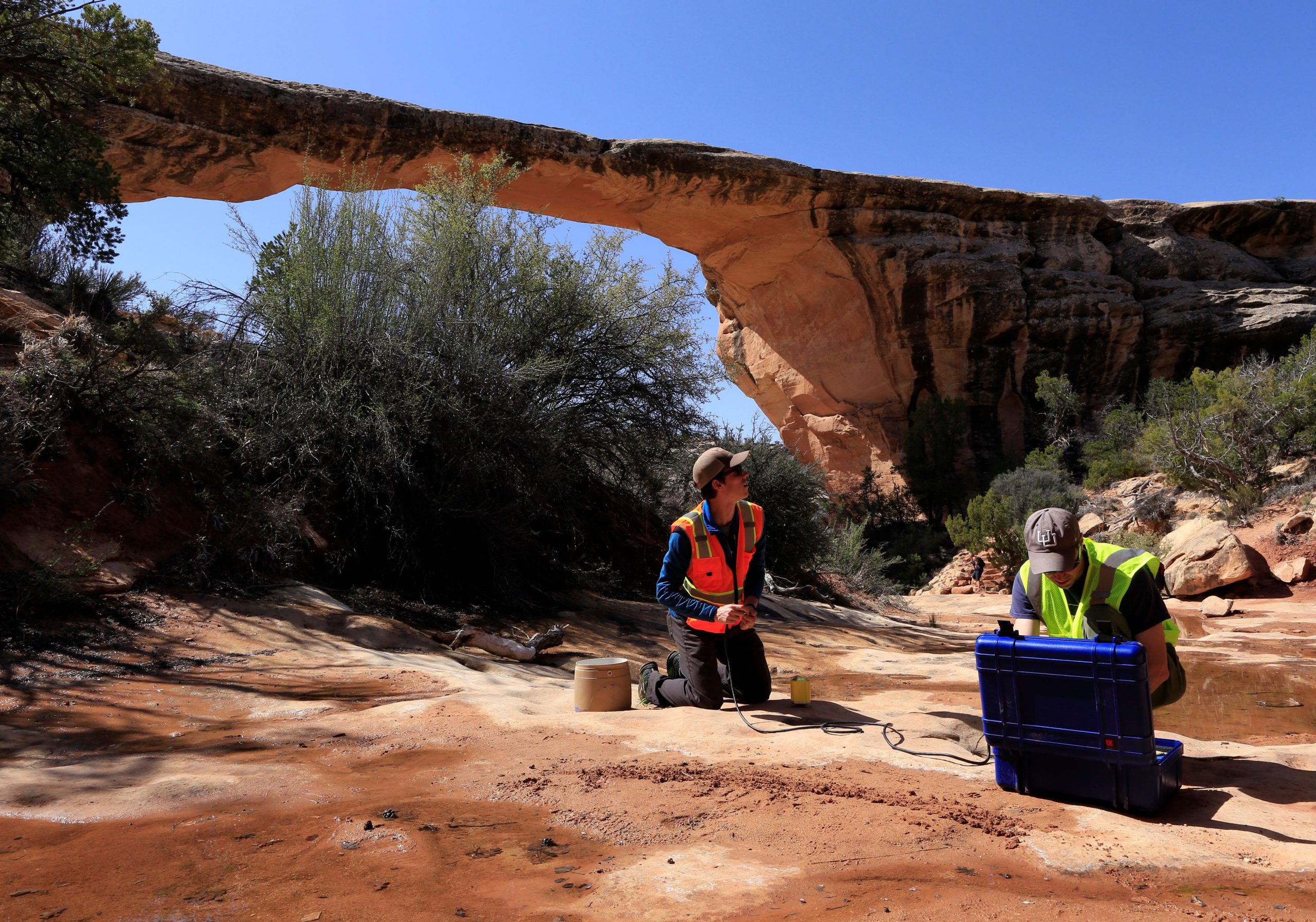Some information may be outdated.
The geological formations known as arches can be seen, touched, smelled, and even tasted, but did you know they could be heard?
In fact, arches are constantly vibrating at specific frequencies below human hearing. By speeding up those vibrations to an audible range, humans can “hear” an arch.
This week, Science Moab speaks with geologists Jeff Moore and Paul Geimer about the science behind arch vibrations and their unique “sound prints.” Moore is the leader of the University of Utah’s Geohazards Research Group, of which Geimer is a member.
Science Moab: Tell us about your work studying arch vibrations.
Moore: Arches are constantly in motion. Every second of every day, they’re vibrating.
Geimer: To measure the vibrations, we use the same equipment that measures earthquakes, placing it right up on the rock surface. We aim to get as close to the center of the [arch] span as we can, since that’s where the largest amplitudes of vibrations occur.
We also usually place another instrument on a similar rock type about 100 meters away to capture background vibrations. By looking at the differences between those two vibration signals, we can tease apart the vibrations generated by the arch versus those generated by some other source.
Science Moab: What is causing arches to vibrate?
Moore: A great variety of energy sources. The earth is alive with seismic energy, and this excites resonant vibrations. Wind is a great exciter of resonant vibrations, but even without wind, arches are still in motion. A great variety of anthropogenic sources also stimulates vibration. Road traffic, train traffic, air traffic: all of these generate vibrational energy, and if their frequencies match the resonant frequencies of the arches, then they stimulate vibrations.
Science Moab: Is there any way to tell if an arch is becoming unstable through these vibrations?
Moore: The whole concept behind this sort of structural health monitoring is that the resonant frequencies of a vibrating mechanical system are simply a function of the geometry and material properties of that system. Material properties are basically mass and stiffness. So if something changes in the mass or the stiffness of the system, and you can make many measurements of resonant frequencies over time, you can indirectly sense these mechanical changes.
Between mass and stiffness, it’s usually stiffness that correlates with damage: as a rock becomes damaged, it becomes softer on net. That will manifest as a permanent decrease in resonant frequency.
Science Moab: Where do you share this data?
Moore: We measure arches in Arches, Canyonlands, Natural Bridges, Bryce Canyon, and Rainbow Bridge, and provide feedback to those Parks Service units.
Geimer: The lasting impact of our results comes through the outreach that the parks develop on their own. It’s eye-opening for a lot of people to know that the rocks around them are always moving, and that the movement tells us something about the rocks themselves.
Moore: We find it very fun to share that arches are constantly vibrating at a set of resonant modes that in many ways is like a guitar string. If you understand the different modes of vibration for a guitar string, arches are doing something quite similar to that. Arches also get torsional modes where they twist, and all kinds of fun things. We make visualizations from our computer models, which are highly exaggerated, but show how the arch is actually moving day in, day out.
The other quite exciting thing that we do is to turn these vibrations into sound. We take vibration measurements and simply speed them up to reach audible range. Now, you can experience each arch as a sound, because each landform’s set of resonances, and therefore its vibration and sound “fingerprint,” is unique.
Science Moab: What causes each arch to have a different resonant “fingerprint”?
Moore: Geometry plays the first control on the vibrational fingerprint of each landform. The larger and more slender the feature, the lower the resonant frequencies and so the lower the resonant tone. This is because larger features have higher masses, while more slender features have a lower stiffness and are more flexible.
Geimer: I like to think that you can “hear” the size of the arch. Rainbow Bridge is a low rumble; play something 10 or 100 times smaller, and you immediately hear the difference: it’s a higher-pitched buzzing.
Science Moab is a nonprofit dedicated to engaging community members and visitors with the science happening in Southeast Utah and the Colorado Plateau. To learn more and listen to the rest of Jeff Moore and Paul Geimer’s interview, visit www.sciencemoab.org/radio. This interview has been edited for clarity.
Appreciate the coverage? Help keep local news alive.
Chip in to support the Moab Sun News.





